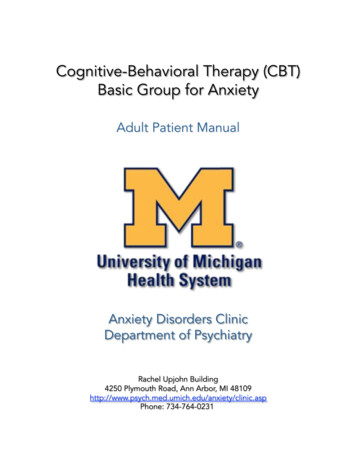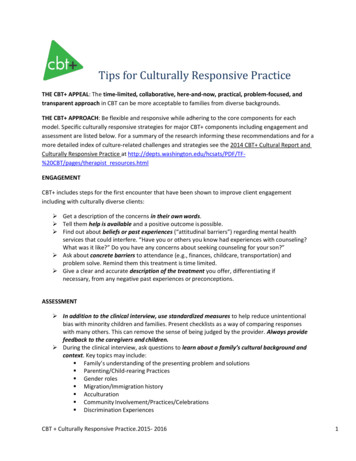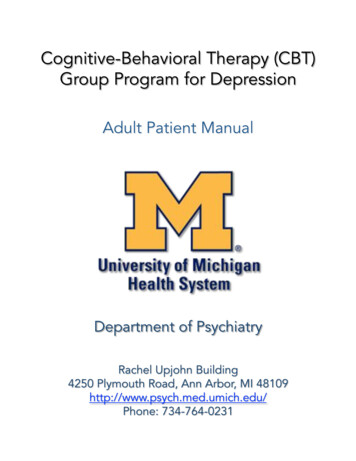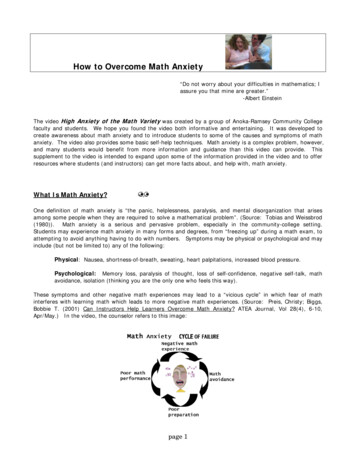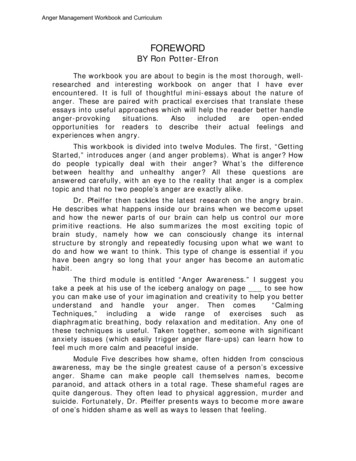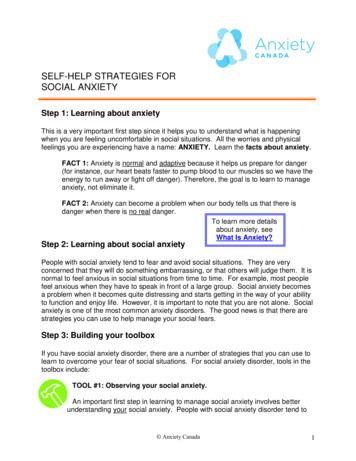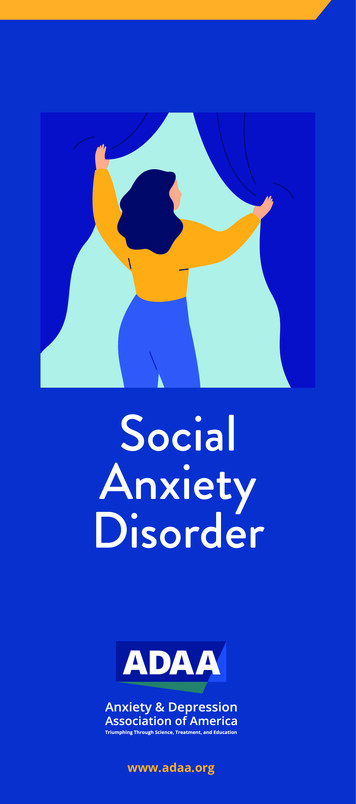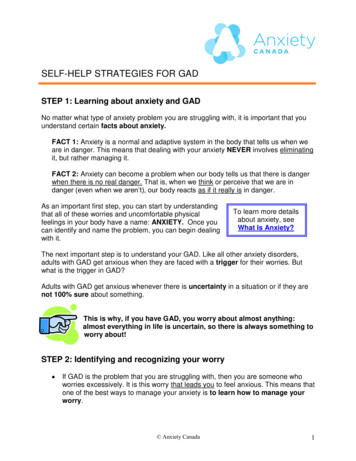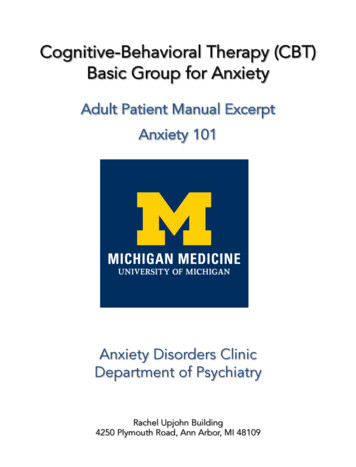
Transcription
Cognitive-Behavioral Therapy (CBT)Basic Group for AnxietyAdult Patient Manual ExcerptAnxiety 101Anxiety Disorders ClinicDepartment of PsychiatryRachel Upjohn Building4250 Plymouth Road, Ann Arbor, MI 48109
AcknowledgementsCognitive-Behavioral Therapy (CBT) Group Program for Anxiety Patient ManualWritten by Dan DeSena, LMSW, DMAEditors:Pam Schweitzer, APRN, BCLaura Lokers, LCSWRicks Warren, PhDBased in part on the knowledge and expertise of:James Abelson, MD, PhDJoseph Himle, PhDLaura Lokers, LCSWPam Schweitzer, APRN, BCRicks Warren, PhDi.
AcknowledgementsCognitive-Behavioral Therapy (CBT) Group Program for Anxiety Patient ManualParts of this manual were broadly adapted and integrated from the followingsources about anxiety, Cognitive-Behavioral Therapy, and group psychotherapy:Barlow, D.H. & Craske, M.G. (2007). Mastery of your anxiety and panic, 4th Ed. New York:Oxford.Beck, J.S. (2011). Cognitive therapy: Basics and beyond (2nd ed.). New York: Guilford Press.Craske, M.G., Antony, M.M. & Barlow, D.H. (2006). Mastering your fears and phobias, 2nd Ed.New York: Oxford.Craske, M.G. & Barlow, D.H. (2006). Mastery of your anxiety and worry, 2nd Ed. New York:Oxford.Craske, M.G., Treanor, M., Conway, C., Zbozinek, T. Vervliet, B. (2014). Maximizing exposuretherapy: An inhibitory learning approach. Behaviour Research and Therapy, 58, 10-23.Davis, M., Eshelman, E.R. & McKay, M. (2008). The relaxation & stress reduction workbook, 6thed. Oakland: New Harbinger.Foa, E.B., Yadin, E. & Lichner, T.K. (2012). Exposure and Response (Ritual) Prevention forObsessive-Compulsive Disorder, 2nd Ed. New York: Oxford.Hope, D.H. & Heimberg, R.G. (2010). Managing social anxiety: A Cognitive-BehavioralApproach. 2nd Ed. New York: Oxford.LeDoux, J. (2015). Anxious: Using the brain to understand and treat fear and anxiety. New York:Penguin Books.Rothbaum, B. & Foa, E.B. (2007). Prolonged Exposure Therapy for PTSD: Emotional processingof traumatic experiences. New York: Oxford.ii.
Cognitive-Behavioral Therapy (CBT) Basic Group for AnxietyGroup GuidepostsWhat is this group all about? Our group is an introduction to the basic conceptsand skills of CBT. There are four sessions, each with a different topic. You can attend these in any order you like. Each session will cover just some of these CBT skills.If you have questions during the group, please ask!It is also possible any confusion you have at thebeginning will clear up as you continue to attend thesessions. This group is not meant to fix your anxietycompletely. We want to give you a chance to try outsome of these techniques and understand youranxiety better. When you get done with this groupyou may want to continue with group or individualCBT treatment here or with a therapist in thecommunity.What is Cognitive-Behavioral Therapy?Cognitive-Behavioral Therapy (CBT) is a short-term,evidence-based treatment for many problems,including anxiety. It is based on the principle thatcognitions (thoughts), behaviors (actions/choices)and emotions (feelings) all affect each other. Beingaware of and changing how we act, think, andrespond to emotions can help us keep anxiety fromcontrolling our lives.Feelings (emotions)Thoughts (cognitions)Weekly Group topics:Anxiety Vulnerability Management (week 1)Do you ever think you have more anxiety thanother people? Find out why and learn how touse CBT skills to fight your anxiety over thelong term.Relaxation and Mindfulness (week 2)Just relax! What to do and when to tryrelaxation strategies to help make you feel lessstress and tension in your daily life.Exposure and Desensitization (week 3)“Avoid avoidance:” how our behaviors canmake anxiety worse, and the surprising way tolearn to manage it!Cognitive Therapy Skills (week 4)Our thoughts matter! Learn ways our thoughtscan change how we feel and influence whatwe do. Turn thoughts into your ally, instead ofyour enemy.We want to be sure that our treatment iseffective!Evidence-based means that there is scientificevidence to show that something works.CBT is an evidence-based treatment that hasbeen studied and shown to be effective inhundreds of scientific experiments.Behaviors (actions)While there is no 100% guarantee that CBTwill work for you, it is likely that with practiceand hard work you will receive benefit fromthese techniques.How to use this manualThis manual includes a lot of information on anxiety and CBT—more than we have time to cover in the group sessions. You will getthe most out of this group if you take notes during the group and then review the manual between sessions. Remember thatdifferent people get benefit from different CBT skills, so we expect that you will use the skills that work and let go of the rest. Wehope that you will try each skill out to determine if it suits you. Refer to “Appendix Iii: This is so much information! Where do Istart?” to make your reading more efficient by starting with the information most pertinent to your particular problem. Finally, besure to bring the manual back next week!iii.
The Path Through Psychotherapy There is a great deal of scientific research onpsychotherapy, and we know a lot about whatcan be helpful for people. We continue tolearn more and more about how to usepsychotherapy to help as many people aspossible.However, because everyone is different, andour brains and lives are very complex, it isoften hard to know exactly what it is that willhelp a particular person feel better.On the next page, follow thepath from the bottom of thepage upward for some tips tomake your “path throughpsychotherapy” more helpfuland rewarding.iv.
v.The Path Through Psychotherapy, con.See this as just one piece of the puzzle in your process of better understandingyourself and moving toward what you want in your life. Get all you can out of itand then make efforts to find out what other types of work could be helpful. Forexample, maybe you did a great deal of work on managing your anxiety withcognitive and behavioral skills. Now you believe that you want to improve yourrelationships to achieve more in that area of your life.Manage barriers to showing up regularly to treatment and practicing skills: improvementdepends primarily on follow-through and the amount of work you put into your therapy.Address anxiety from different angles. There is no one “silver bullet” that willchange anxiety all by itself. Usually a “combination treatment,” or mixed approachis what works best to make anxiety better. This also means putting in some effortto understand different ways to manage your anxiety.Practice skills over, and over, and over. It usually takes time for changes in ourbehavior and thinking to lead to us feeling better. Like learning a musicalinstrument, we are practicing new ways of doing things that will feel “clunky” atfirst, and become more comfortable over time.Take small steps toward change each day. Try not to wait for “light bulbmoments,” “epiphanies,” or for something to take anxiety all away instantly.Expect ups and downs during the process. Think of it as “2 stepsforward, 1 step back.” Try not to get discouraged or give up whenthings seem to move backward or stagnate.Make it about you: engage in your treatment because you want to improve your life.Take responsibility for achieving your aims to feel better, not because others are tellingyou to do so. Remember that even if you are being pushed to engage in therapy bysomeone else, that relationship must be important enough for you to consider thisoption!Maintain an open mind about the possibility of change, while being realisticabout how fast this change can happen.Especially at first, gauge success according to how you change your responses to stress,uncomfortable emotions, and body sensations, not whether or not these things exist orcontinue to occur. Focus on valued action, even more than just “feeling better.”“Credibility:” Make sure the treatment in which you are engaging makes sense toyou and seems to be addressing your problem. There are different paths to thesame goal. If this type of therapy is not working for you, you are confused aboutwhat you are doing, or you have any other concerns, talk to your clinician rightaway. Clinicians are trained to have these discussions with their patients.Make sure your definition of the “problem” is the same as the clinician’s withwhom you are working. Maybe they think it is “anxiety” and you think it issomething else. Try to clarify this with your clinicians.
Anxiety 101“We experience moments absolutely free from worry. These brief respites are called panic.” Cullen HightowerThis part of the group is meant to explore important information about anxietyitself. The first step to managing anxiety is understanding it as well as we can— to“know thine enemy,” so to speak.On the pages entitled “Anxiety is ” and “Why does my body dothis?” we’ll talk about:-What the anxiety “alarm” really is—the “fight or flight”response— and what its common symptoms are-The difference between normal anxiety and “phobic”anxiety-What causes anxiety-Why our bodies do what they do when we are anxious-Why we can’t just “get rid of” the anxietyIn the section “Anxiety Triggers,” we’ll go over the differentthings that can trigger anxiety and how the brain comes tobelieve these triggers are dangerous.In our final section, “Anxiety Fuel,” we learn about commonways that anxiety can get worse, and how our own thoughtsand behaviors play a role in this process.1.1
Anxiety Is Anxiety is a part of our bodies’ natural alarm system, the “fight or flight” response, which exists to protectus from danger. These natural body responses are not harmful— but they are really uncomfortable!The most pure form of the “fight or flight” response is a panic attack, which involves a rush of anxiety symptoms, manyof which are listed below, usually peaking in about 10 minutes. In these cases, the body is trying to tell us “somethingdangerous is happening right now!” Other forms of anxiety that are less acute but often just as debilitating, such aschronic worry, involve symptoms similar to the “fight or flight” symptoms of panic attacks. However, in these cases, it isas if the body is saying “something dangerous is going to happen sometime in the future so watch out!” Thedifferences between the two are the intensity of the response and the context in which it is triggered. In this manual wewill refer to all anxiety symptoms as being related to the “fight or flight” response. The most common anxiety symptomsare listed below. Try circling the ones that apply to you.Physical Symptoms-Rapid heartbeat-Sweating-Trouble breathing-Tightness in the chest, chest pain-Dizziness-Feeling: “Things aren’t real”-Feeling: “I don’t feel like myself.”-Tingling and numbness in fingers, toes,and other extremities-Nausea, vomiting-Muscle tension-Low energy, exhaustion-Changes in body temperature-Shaking, jitters-Urgency to urinate or defecate-Changes in vision and other sensesCognitive (thinking) SymptomsBehavioral Symptoms-Worries-Negative thoughts about one’s ability totolerate emotions or future stress-Negative predictions about futureevents-Other common thoughts:“I am going crazy!”“I am going to have a heart attack!”“I am going to faint.”-Trouble concentrating or keepingattention-Magical ideas, phrases or images, such as“If I do not wash my hands I will die orsomeone will be harmed.”-Preoccupation with body sensations orfunctions-Avoidance of anything that provokesanxiety, including people, places,situations, objects, animals,thoughts, memories, bodyfeelings, etc.-Protective, “safety” behaviors-Aggression, verbal abuse, lashing out-Alcohol and/or drug use-Compulsive behaviors, such asexcessive checking or otherunreasonable or harmful rituals orroutinesWhat causes anxiety?We know from scientific research that anxiety is caused by a combination of factors related to both “nature” (genetics)and “nurture” (experience). Check out page 5.4 for a more detailed explanation of the factors that can lead to anxiety.When “fight or flight” goes too far: “Phobic” anxietyEveryone experiences anxiety from time-to-time. We often get the question:“How do I know if I have an anxiety disorder?” An anxiety disorder is diagnosedwhen someone experiences anxiety symptoms and these symptoms: Interfere with a person’s life aimsHappen too often or with too much intensity, given the actual danger of asituationAre not explained by other factors, such as a medical problem or substanceabuseSome people experience significant anxiety and choose simply to live with it. Itis up to you to decide if you can handle the anxiety on your own, or if treatmentis necessary.Take home point:The symptoms of anxiety are the “fight or flight” response, and are normal,functional, and necessary for survival. They become a problem when they are toosevere or happen too often, given the real amount of danger present, or if theyinterfere with the activities of life.Remember: Anxiety is uncomfortable, not dangerous!Why can’t I just get rid ofmy anxiety?Anxiety is as vital to our survivalas hunger and thirst. Without our“fight or flight” response wewould not be as aware ofpossible threats to our safety.We also might not take care ofourselves or prepare adequatelyfor the future. And we probablywouldn’t enjoy a scary movie ora roller coaster!Anxiety is necessary, as itprotects us and can even be funat times. It isn’t in our bestinterest to get rid of itcompletely.1.2
Why does my body do this?1.3There is a reason!We have evolved over millions of years to better protect ourselves. Our brains have learned to automatically signaldanger when it is present or we perceive that we may be harmed in some way. Each symptom of anxiety has a specificevolutionary purpose: to help us “fight” or “flee.”Try to figure out how each symptom of anxiety is used by our bodies to protect us when we are in danger, by matchingthe evolutionary purpose with the anxiety symptoms. Some in the right-hand column may be used twice, and there maybe multiple answers for some symptoms. Once you are done, you can see if you were right— the answers are at thebottom of the page.Anxiety Symptom1. Rapid heartbeatPurposeA. Muscles contract and tighten to help us fight or flee2. Sweating3. Flushing in face4. Tightness in the chest, chest painB. Push blood around the body faster to supply cells withoxygen in case we need to use energy to flee or protectourselvesC. Lots of energy is spent for body to protect us5. Feeling: “Things aren’t real”6. Feeling: “I’m not myself”7. Tingling or numbness in fingers and toes8. Nausea, vomiting9. Muscle tension, stiffness10. Low energy, exhaustion11. Changes in body temperature12. Shaking, jitterinessD. Body increases speed and depth of breathingE. Thoughts tend to be negative and protective; it is dangerousto have “good” thoughts if we are in danger!F. Must stay alive, even if it means using forceG. Try to think of ways to protect ourselves in case bad thingshappen in futureH. Brain is constantly scanning for danger, from one thing tonext13. Urgency to urinate or defecate14. Hyperventilation or trouble breathing15. Dizziness, lightheadedness16. Worries17. Negative predictions about future eventsI. Body stops digestion and attempts to rid itself of excessiveharmful substancesJ. If something is dangerous, remember it and get away from it!K. Cools us off when we are running or fighting and makes itharder for a predator to grab us18. Trouble concentrating or keeping attention19. Avoiding20. Fighting or aggressionL. Blood is redirected away from head, skin, fingers, and toes; ifwe are cut, we will not bleed to death as easilyM. Decrease in salivation21. Changes in vision, hearing, smell, taste22. Dry mouthDid you know when our body’s “fight or flight” alarm is triggered, a domino effect of chemical changes and messagesare sent to various parts of the brain and body, producing these symptoms. This process is programmed to last onlyabout 10 minutes, unless it is triggered again.Answers: 1. B 2. K 3. B 4. A,D 5. L 6. L 7. L 8. I 9. A 10. C 11. L 12. A 13. I 14. D 15. L 16. E 17. G 18. H 19. J 20. F 21. L 22. M
Anxiety “Triggers”Our brains are designed to keep us safe. Theanxiety part of the brain, the amygdala, is like aradar that is trained to spot dangerous objectsand situations. When this “radar” spotssomething that could be dangerous, it tells thebrain to begin the “fight or flight” response,producing the uncomfortable feelings we getwhen we are anxious.“One thing leads to another:” how a trigger becomes connected with our “fight or flight” responseWhen we perceive danger, whatever it is that could be dangerous (in this case, a spider) is remembered by theamygdala. The next time something reminds us of the spider, or we actually come into contact with one, our anxiety“alarm” goes off.!!! “danger” or something bad happening(for example, getting bitten by the spider) Now and infutureTypes of anxiety triggers and the Anxiety Disorder “Diagnosis”Nearly anything can be trained to trigger the “fight or flight” response. Psychiatrists, psychologists, psychiatric nurses,and clinical psychiatric social workers have tried to find ways to tell the difference between different types of anxietytriggers. Anxiety disorder diagnoses come out of this attempt. While a diagnosis is not a perfect way of describing aperson’s experiences, it can help us to know what types of treatments may be effective. Different groups of triggers andthe diagnoses most frequently associated with them are listed below. Some of these categories overlap, and it ispossible for one person to have more than one diagnosis.TriggerDiagnosisWorries, predictions, and negative thoughts about the futureGeneralized Anxiety Disorder (GAD)Social situations and people, such as social events and performances,along with fear of criticism from othersSocial Anxiety Disorder (Social Phobia)Fear of having a panic attack and fear of body feelings that remind oneof panic attacksPanic DisorderPlaces a panic attack has happened before or could happenAgoraphobiaPlaces, situations, animals, objects, blood or injury, etc.Specific PhobiasDisturbing intrusive thoughts, contamination, doubt and urge to checkthings, etc.Obsessive-Compulsive Disorder (OCD)Memories and things associated with a traumatic eventPost-Traumatic Stress Disorder (PTSD)1.4
Anxiety “Triggers,” continued“Which came first, the chicken or the egg?”Scary event?Anxiety?Some people wonder if scary events caused their anxiety, or if their anxiety itself is what causes them to more readilysee things as scary.We know from scientific research on anxiety that both are true. Events and stress in ourlives can create more anxiety. For example, a passenger on a flight that barely escapes anserious accident may feel anxiety the next time they take a flight, especially if this wasone of their first flying experiences. Flying may then become a new anxiety trigger.Conversely, someone that is already vulnerable to having anxiety may experience normalturbulence on a flight as scary and then feel afraid to fly in the future.What if I don’t know what triggers my anxiety?For the sake of treatment, it is important to learn to identify what it is that makes you anxious. For some people it isvery clear; for others, anxiety seems to come from “out of nowhere.”To identify what makes you anxious, ask yourself the following questions:“When I feel scared or nervous, what is going on around me or what am I thinking about?”“Am I worried about having more anxiety in the future?”“Am I afraid of body sensations that remind me of intense anxiety attacks?”“Do I ever try to do more than I can handle or create unrealistic expectations for myself or others?”“Am I worried that I will not be able to cope if bad things happen in the future?”Anxiety “Triggers” take home points:The brain can learn to be afraid ofalmost anything, and some anxiety“triggers” are more common thanothers. These triggers help defineanxiety disorder diagnoses, which weuse to better understand the anxietyand develop treatments.Anxiety can be caused by scary events,and anxiety can also make one morelikely to experience an event as scary.It is important to understand youranxiety “triggers.” In most cases it ispossible to figure them out yourself.Sometimes it is necessary to have thehelp of a mental health professional todo so.ExerciseMy anxiety triggers are:List here the objects, situations, events, or places that tend to trigger youranxiety. Use the questions above if you are having trouble figuring outwhat makes you anxious.1.2.3.4.5.6.7.1.5
1.6Anxiety “Fuel”When we feel anxious, we typically want to do something to make ourselves feel better.Most of these behaviors feel natural because our bodies also want to keep us safe.However, some of these behaviors can make things worse; by adding “fuel” to the anxiety“fire.” We can add fuel gradually over time or dump lots on all at once. In all cases theanxiety “fire” gets bigger.What behaviors are in danger of causing the anxiety to get worse? Anything that teaches the amygdala (the anxietycenter of the brain) that something is dangerous. Remember our spider example? Let’s say that every time this mansees a spider he tries to avoid it by getting away. What does this teach him? That the spider is dangerous, ofcourse!“Danger!!” Each time he avoids the spider, his amygdala gets more feedback that the spider is dangerous. Next time he seesthe spider, his anxiety “alarm” will be louder, or it may go off more quickly than before. The process by which thebrain learns that something is more dangerous over time is called sensitization. It is also called reinforcement of theanxiety because the anxiety response gets stronger and stronger. Reinforcement can happen both in the short term(when the danger seems to be present) or in the long term, as we discuss below.Short-term reinforcement: the anxiety “snowball effect”Have you ever worried about speaking in front of a group of people? Worries about performing well can lead tojitteriness, cracking voice, difficulty concentrating, and other “fight or flight” symptoms. Often the physical anxietysymptoms will then create more worry about the performance; this creates a “snowball effect,” in which anxietygets worse and worse, even to the point of panic.Worry aboutspeech“Fight or flight” symptoms during speech“People may see that I amnervous!”(more worry)
Anxiety “Fuel,” continuedLong-term reinforcement: “Safety Behaviors” and negative thoughts/beliefsAs mentioned earlier, anxiety “fuel” is anything that teaches the anxiety center of the brain, theamygdala, that something is dangerous. Over the long term, the most common ways to do this involvenegative thoughts and beliefs as well as protective actions called safety behaviors. While thesebehaviors seem to help the anxiety in the moment, they usually make it worse in the long run. Examplesare listed below.BehaviorsSafety behaviors are often justified using “as long as”statements:Avoidance: “As long as I avoid that, I will be safe.”Attacking others, acting on anger, etc.: “As long as I useverbal or physical force to protect myself, I will havecontrol.”Protective behaviors: “As long as I have my water bottlewith me, I am safe and will not have another panic attack.”Rituals (usually part of OCD, characterized by excessive,repetitive checking, washing, counting, asking forreassurance, etc.): “As long as I knock four times when Ihave a scary thought, nothing bad will happen to mydaughter.”Substance use (trying to “numb” the anxiety): “As long as Ican have some alcohol, I will feel better.”ThoughtsNegative thoughts about:-the future-yourself-other people-the worldExamples:“I am going to lose my job and end uphomeless.”“I must have control ”“That person thinks I am an idiot.”“If I drive on the highway I will get intoan accident.”“If I keep having this thought it must betrue.”Whether in the short run or over time, anxiety feelings, fearful thoughts, and protective, “safety”behaviors work together to keep our anxiety “fire” burning. Each feeds off the others, and any one ofthese can act as the “match” to get the fire started. In CBT, our goal is to work on these thoughts andbehaviors to help extinguish the fire as much as possible.Anxiety symptoms (“fight or flight” response)Fearful thoughtsSafety behaviors1.7
Anxiety “Fuel,” continuedAnxiety “Fuel” take home points:Some of our thoughts and behaviors, while they seem to help us, actually make anxiety worse. Safety behaviors,such as avoidance and protective behaviors, as well as negative thoughts, serve to reinforce anxiety in both theshort- and long-term.It is important to understand what, if any, safety behaviors we are using, so that we can work to reverse thisthrough treatment.Exercise: Anxiety “Fuel”Below, list some of the ways you may accidentally make your anxiety worse, based on the material discussedabove.AvoidanceAnger and IrritabilityDo I avoid anything because it seemsscary or makes me feel anxious? Thismay include avoiding thinking aboutsomething or avoiding certain types ofsituations or people.Do I become angry or irritableand attack others verbally orphysically?Things I avoid:1.1.2.2.3.3.4.4.What I do when I am angry:5.1.6.2.7.3.Times I become angry:Protective “Safety” BehaviorsDo I try to protect myself in certainsituations in order to feel more safe?How I try to protect myself:1.2.3.4.5.6.7.8.4.Substance UseThoughtsDo I ever use drugs or alcohol in order to “numb”the anxiety?Do I have thoughts that come up continually and makeme feel anxious?Types of drugs or alcohol:Thoughts that make me feel anxious:1.When I tend to drink or use drugs:2.3.4.5.6.1.8
Anxiety 101SummaryAnxiety Is Why does my body do this?We learned that the symptoms of anxiety arethe “fight or flight” response, and are normal,functional, and necessary for survival. Theybecome a problem when they are too severeor happen too much given the real amount ofdanger present, or if they interfere with theactivities of life. While having chronic anxietyover long periods of time puts stress on thebody, it can be helpful to remember thatanxiety itself is not dangerous; but it sure canbe uncomfortable.In this section we covered the ways thateach “fight or flight” symptom functions toprotect us in case we are in real danger.Anxiety TriggersAnxiety FuelWe learned that the brain can learn to be afraid ofalmost anything, and some anxiety “triggers” aremore common than others. Anxiety disorderdiagnoses are organized based on what triggersthe anxiety.Some of our thoughts and behaviors, whilethey seem to help us, actually make anxietyworse. Safety behaviors, such as avoidanceand protective behaviors, as well as negativethoughts, serve to reinforce anxiety in boththe short- and long-term.We know that anxiety can be caused by scaryevents, and anxiety can also make one more likelyto experience an event as scary.It is important to identify your anxiety “triggers.”In most cases it is possible to figure them outyourself. Sometimes it is necessary to have thehelp of a mental health professional to do this. Afew tips are on page 1.5.We also learned that when our body’s “fightor flight” alarm is triggered, a domino effectof chemical changes and messages are sentto various parts of the brain and body,producing these symptoms. This process isprogrammed to last only about 10 minutes,unless it is triggered again.It is important to understand how we makeour anxiety worse, so that we can work toreverse this through treatment.A common question: What if it really is dangerous?Of course, we are not trying to ignore anxiety or feel calm if something really is dangerous. One of our goalsin CBT is to learn what is dangerous and what is not, what we can control and what we can’t, and how tobalance taking risks with keeping ourselves safe.If you are here, it is likely that the cost of trying to keep yourself safe is outweighing the advantages. We’ll beexploring this more in some of our other modules.1.9
Notes
Notes
Anxious: Using the brain to understand and treat fear and anxiety. New York: Penguin Books. Rothbaum, B. & Foa, E.B. (2007). Prolonged Exposure Therapy for PTSD: Emotional processing of traumatic experiences.New York: Oxford. Cognitive-Behavioral T
